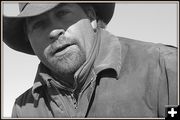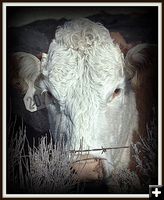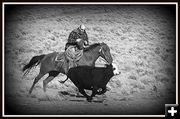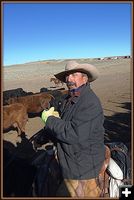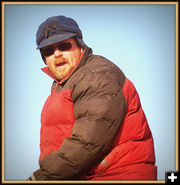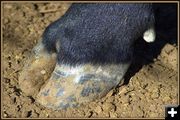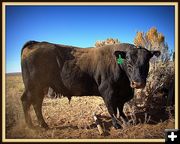
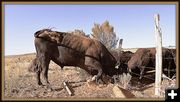
Herd Bull Gets Challenged
This bull has spent all summer out-witting bears and wolves in the Upper-Green wilderness. He passed on those genes over the summer and new calves will be born in the spring who will then test his/her wits against nature.
Last year, ranchers lost 11% of their calves.
If you are what you eat, I guess there's a good argument to be made for eating beef tempered in Grizzly Country.
|

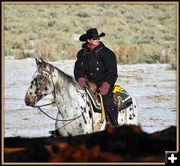
Tara
Yep, that's snow on the ground with wind chill at about zero...and Tara doesn't wear a cover on her ears. Is there a competition to see who cries "Uncle" first?
That's a line of cattle at the bottom of the photo in case you aren't from around here.
|

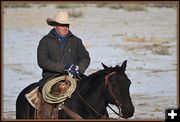
Phil Selby Sr.
Fresh snow and wind at about 25 MPH this morning taking the temp down to about zero. Phil Selby, Sr. didn't seem to be bothered enough to cover his ears. I mentioned that fact to his son Phil, Jr. "Yeah, he's a Bad Ass," he said. I'm guessing some folks are just born that way.
|

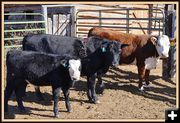
Bears Attack
She made it home to the Sommers Ranch, but her future is uncertain.
|
|
The Green River Valley Drift 2017
Hard Work and Hazards for Man and Beast
by Terry Allen
October 15, 2017
When Grizzly bears attack they go right for the Withers. This is the same general area on a fighting bull’s neck into which a matador plunges his sword. Rising on his toes, a skilled matador executes the kill with a single powerful downward thrust and the sword finds the heart of the bull. A Grizzly runs down the cow, calf or bull and then rises up on its hind legs and sinks its teeth where the spinal cord and arteries run and holds on with teeth and claws trying to bring the animal down. Their jaws have the power to snap six inch thick pine trees. The strike force of a paw has been said to be capable of decapitation.
Just days ago, a Mother cow survived such an attack. She and her calf…which survived unhurt…are recovering at the Sommers Ranch. Jonita Sommers invited me down to her ranch and the graphic photos are included in this story. Grizzlies can feed on carcasses for a long time. That means they feed on rotted meat that harbors dangerous bacteria and the live cattle they prey on and sink their teeth and claws into may become dangerously infected and eventually die. While Jonita remains positive on the cows chances of survival, she is not certain.
Kent Price told me as of Sunday, the Game and Fish have confirmed 80 cow/calf kills in the Upper Green, but this is not a final number. Kent said the general feeling is that this year’s numbers will be as bad as last years. Last year, they lost 11% of their calves.
The cattle drift north into the national forest each spring after their calves are born. There they eat on leased national forest grazing allotments. Camp Riders stay in the forest and watch over the cattle as best they can. They doctor the sick, sew up the wounded ones, and keep a tally and location of dead ones. They carry heavy caliber hand guns that are good for the close quarter combat with Grizzlies and Wolves that hunt in or lay in wait among the willow and brush tunnels the cattle like to graze and shelter in. Cattle can also get stuck in mud bogs or break a leg and die.
Those that survive the summer, head south along The Drift toward the Trappers Point Gathering Grounds as soon as the first hard freeze hits.
You might remember young Libby and Lacey from my Centennial Ranch Branding story this spring. They stayed busy Sunday at the gathering grounds running down cows and calves that wanted to break out of the gathered herd and run back north. A spotted faced calf is particularly persistent and kept them busy today.
I kept my ears open and learned that two ranchers have about 30 to 35 dry cows each. That means their calves didn’t survive the summer. I haven’t heard what the other seven ranchers think they have lost.
Once everyone gets their cattle back to their home ranch, they sort them out for various purposes. Jonita said she doubts the Grizzly slashed cow got bred, so even if she survives they won’t get a calf out of her. She also said the heavy predation on the cattle make it difficult to maintain the genetic strength of her herd. "On a positive note," she said. "Cattle buyers like our cattle because the ones that are left, are strong."
Thank you, Dawn Ballou for sponsoring this important local story.
Your photographer, Terry Allen: txpartisan@gmail.com
|

